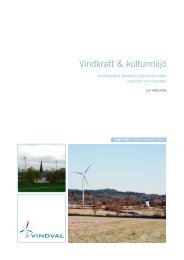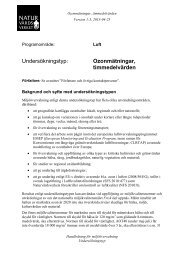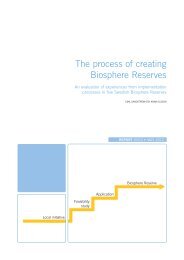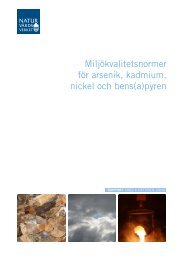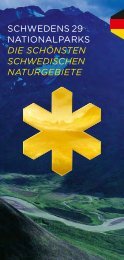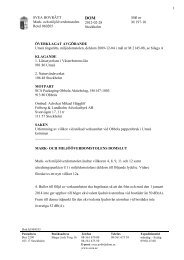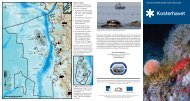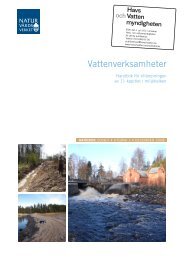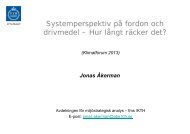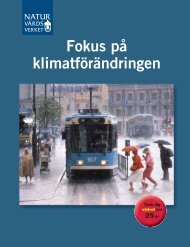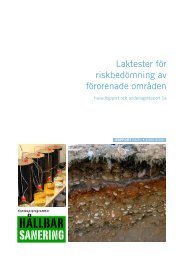Ecosystem services provided by the Baltic Sea ... - Naturvårdsverket
Ecosystem services provided by the Baltic Sea ... - Naturvårdsverket
Ecosystem services provided by the Baltic Sea ... - Naturvårdsverket
Create successful ePaper yourself
Turn your PDF publications into a flip-book with our unique Google optimized e-Paper software.
SWEDISH ENVIRONMENTAL PROTECTION AGENCY<br />
Report 5873 • <strong>Ecosystem</strong> <strong>services</strong> <strong>provided</strong> <strong>by</strong> <strong>the</strong> <strong>Baltic</strong> <strong>Sea</strong> and Skagerrak<br />
Economic Marine Information<br />
Supporting ecosystem <strong>services</strong><br />
S5: Maintenance of habitat<br />
Definition<br />
Marine habitat typically refers to benthic or littoral habitat structure and habitat<br />
forming biota. In a broader perspective, habitat is simply <strong>the</strong> environment in which<br />
an organism occurs. From this definition, it should be obvious that habitats – of all<br />
kinds - are essential to maintain ecosystem diversity and function. Never<strong>the</strong>less,<br />
some habitats are often highlighted as of particular value. For instance, structurally<br />
complex habitats like algal beds or biogenic reefs, as opposed to plain sand or mud,<br />
are often particularly important, as <strong>the</strong>y provide refuges against predation as well<br />
as a variety of different food resources.<br />
Related processes and <strong>services</strong><br />
By supporting diversity and function, essentially all ecosystem <strong>services</strong> are dependent<br />
on <strong>the</strong> maintenance of habitat directly, or indirectly. The provision of fish<br />
for consumption is dependent on presence of habitats used for spawning, feeding,<br />
breeding and growth to maturity – but not only for <strong>the</strong> fish consumed; <strong>the</strong> habitat<br />
requirements of <strong>the</strong> fish that fed <strong>the</strong> fish are just as important. This indirect dependence<br />
on a variety of habitats is illustrated <strong>by</strong> <strong>the</strong> complexity of <strong>the</strong> food web<br />
(chapter S3). Coastal habitats appear particularly important. Among both commercial<br />
and recreational fish landings, species associated with coastal habitats comprise<br />
77 % (<strong>by</strong> weight) (60). In coastal waters, certain habitats are dominated <strong>by</strong><br />
one species; this habitat provider is often crucial to numerous species. Key habitat<br />
builders in our marine environments include marine algae like Fucus and Furcellaria,<br />
sea-grass (Zostera sp.) and blue mussels (Mytilus edulis). The tourism industry<br />
benefits from all habitats supporting attractive wildlife such as marine mammals<br />
and birds, but also habitats that in <strong>the</strong>mselves attract e.g. divers and recreational<br />
boaters. In summary, <strong>the</strong> maintenance of a multitude of habitats safeguards<br />
against ecological surprises while providing <strong>the</strong> best possible conditions for maintaining<br />
diversity, resilience and options for current or future human use.<br />
Not only do habitats affect species distributions; various organisms, including fish,<br />
may also modify <strong>the</strong>ir habitat. The grazing of algae, <strong>the</strong> filtering of water, <strong>the</strong> defecating,<br />
<strong>the</strong> feeding on invertebrate that in turn feed on algae – are all examples of<br />
ways in which marine animals influence <strong>the</strong>ir habitat, and <strong>the</strong> habitat of o<strong>the</strong>rs.<br />
This reciprocal influence should be considered in all aspects of e.g. monitoring,<br />
management and exploitation.<br />
56



